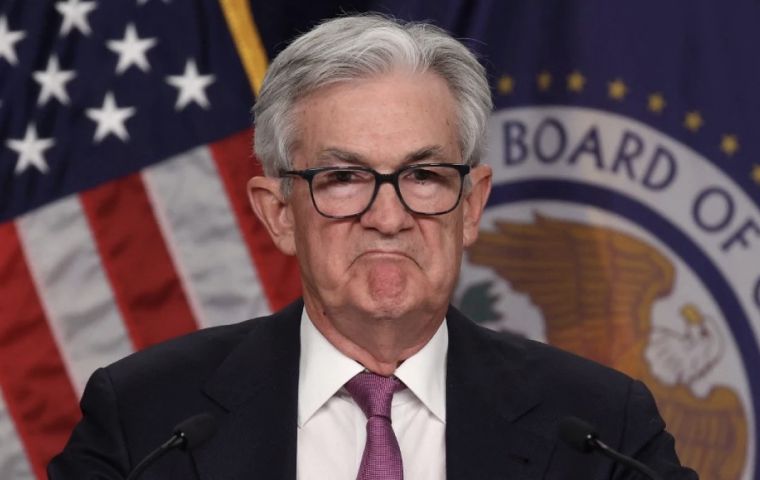MercoPress. South Atlantic News Agency
Fed admits inflation cooling, but more evidence needed that “the disinflationary process has started”
 Powell stressed it was too soon to declare victory over the worst inflation bout in four decades: “We will need substantially more evidence to be confident”
Powell stressed it was too soon to declare victory over the worst inflation bout in four decades: “We will need substantially more evidence to be confident” The Federal Reserve following a two day meeting announced it decided on Wednesday to raise its key interest rate a quarter point arguing that although inflation is easing it is still too high, and did not discard further rate hikes could be needed since more evidence is needed to be confident inflation is in a sustained downward path. The increase was the eighth since March.
Fed chairman Jerome Powell said at a news conference that the Fed recognizes that the pace of inflation has cooled — a signal that it could be nearing the end of its rate increases. The stock and bond markets rallied during the news conference, suggesting that they anticipate a forthcoming pause in the Fed’s credit tightening.
Throughout his remarks on Wednesday, Powell sounded a dual message. He frequently acknowledged signs that high inflation is slowing. “We can now say I think for the first time,” he said, “that the disinflationary process has started.”
Yet he also stressed that it was too soon to declare victory over the worst inflation bout in four decades: “We will need substantially more evidence to be confident that inflation is on a long, sustained downward path.”
The Fed’s rate increase on Wednesday, though smaller than the half point hike in December and the four three-quarter-point hikes before that, will likely further raise the costs of many consumer and business loans and the risk of a recession.
In a statement, Fed officials repeated language they’ve used before, that “ongoing increases in the (interest rate) target range will be appropriate.” That is widely interpreted to mean they will raise their benchmark rate again when they next meet in March and perhaps in May as well.
The Fed chair said that so far, much of the inflation slowdown reflects the prices of goods, notably gas but also furniture, appliances and other finished products that have benefited from an unraveling of supply chain snarls.
But Powell reiterated his concern that prices for services — restaurant meals, health care, airline tickets and the like — are still surging. He has said he pays particular attention to services prices because they are labor-intensive. As a result, robust wage gains can keep services prices elevated and perpetuate high inflation.
The central bank’s benchmark rate is now in a range of 4.5% to 4.75%, its highest level in 15 years. Powell appeared to suggest on Wednesday that he foresees two additional quarter-point rate hikes: “We’re talking about a couple of more rate hikes to get to that level we think is appropriately restrictive,” he said, referring to rates high enough to slow the economy.
“Our focus,” he said, “is not on short-term moves but on sustained changes” in financial markets. He noted instead that many financial gauges, like mortgage rates, are much higher than they were when the Fed began raising rates.
On Wednesday, Powell brushed aside any concern that the Fed will end up tightening credit too much and trigger a recession. “I still think there is a path to getting inflation down to 2%,” the Fed’s target level, “without a significant economic decline or significant increase in unemployment,” he said.
Retail sales in the US, for example, have fallen for two straight months, suggesting that consumers are becoming more cautious about spending. Manufacturing output has fallen for two months. On the other hand, the nation’s job market – the most important pillar of the economy – remains strong, with the unemployment rate at a 53-year low at 3.5%.
In December, overall inflation eased to 6.5% in December from a year earlier, down from a four-decade peak of 9.1% in June. The decline has been driven in part by cheaper gas, which has tumbled to US$ 3,50 a gallon, on average, nationwide, from US$ 5 in June.
In related news the European Central Bank is expected to raise its benchmark rate by a half-point when it meets on Thursday, and the Bank of England is forecast to lift its rate at a meeting Thursday as well. Inflation has reached 10.5% in the United Kingdom.




Top Comments
Disclaimer & comment rulesCommenting for this story is now closed.
If you have a Facebook account, become a fan and comment on our Facebook Page!